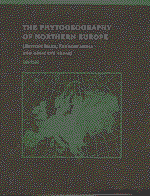Book contents
- Frontmatter
- Contents
- Preface
- Acknowledgements
- 1 Introduction
- 2 Climate
- 3 Edaphic factors
- 4 The geological history of the present European flora
- 5 The atlantic and oceanic elements
- 6 The thermophilic element
- 7 The boreal element
- 8 The arctic, alpine and montane elements
- 9 Endemic, disjunct and centric distribution patterns
- 10 Anthropochorous plants
- Appendix I Calculation of climatic parameters for comparison with plant distributional data
- Appendix II The Northern European species of Flora Europaea with indications of their status and climatic correlations
- Appendix III Arctic species of vascular plants
- Appendix IV Endemic species of vascular plants, bryophytes and lichens
- Appendix V Extra-European disjunctions – bryophytes and lichens
- References
- Index
1 - Introduction
Published online by Cambridge University Press: 23 October 2009
- Frontmatter
- Contents
- Preface
- Acknowledgements
- 1 Introduction
- 2 Climate
- 3 Edaphic factors
- 4 The geological history of the present European flora
- 5 The atlantic and oceanic elements
- 6 The thermophilic element
- 7 The boreal element
- 8 The arctic, alpine and montane elements
- 9 Endemic, disjunct and centric distribution patterns
- 10 Anthropochorous plants
- Appendix I Calculation of climatic parameters for comparison with plant distributional data
- Appendix II The Northern European species of Flora Europaea with indications of their status and climatic correlations
- Appendix III Arctic species of vascular plants
- Appendix IV Endemic species of vascular plants, bryophytes and lichens
- Appendix V Extra-European disjunctions – bryophytes and lichens
- References
- Index
Summary
Phytogeography, as the name indicates, is the scientific study of the geographical distribution of plants. It is a science combining botany and geography. The subject can be approached in at least two ways.
By studying the geographical distribution of assemblages of plants, namely plant communities. This is a phytosociological approach
By studying the geographical distribution of individual plant taxa. This is a phytogeographical approach in a restricted sense and it is the approach that this book adopts.
Both approaches are relevant and inter-related. Results obtained from phytosociological studies can throw light on phytogeographical problems and vice versa. The methods used are, however, quite different.
The basic material in phytosociological studies is the relevé, i.e. standardised descriptions of vegetation plots with lists of species and information about their relative quantities or abundances. Sets of relevés are combined into vegetation tables which can be analysed by different methods. One method is to attempt a vegetation classification, the approach used in classical plant sociology. Another approach is to consider the vegetation table as an information matrix which can be represented as points in a multidimensional space. By using different methods, invariably employing computers, relations between relevés and species can be studied. This is the ordination or gradient analysis approach (Gauch 1982).
The basic material in the phytogeographical approach in its restricted sense is data on the occurrences of individual plant taxa. These are summarised verbally in floras, indicating where the plant in question might be found. Little information can be presented in this way, however. An alternative approach is to make distribution maps of plant taxa. These can be made in several different ways.
- Type
- Chapter
- Information
- The Phytogeography of Northern EuropeBritish Isles, Fennoscandia, and Adjacent Areas, pp. 1 - 14Publisher: Cambridge University PressPrint publication year: 1998
- 2
- Cited by



